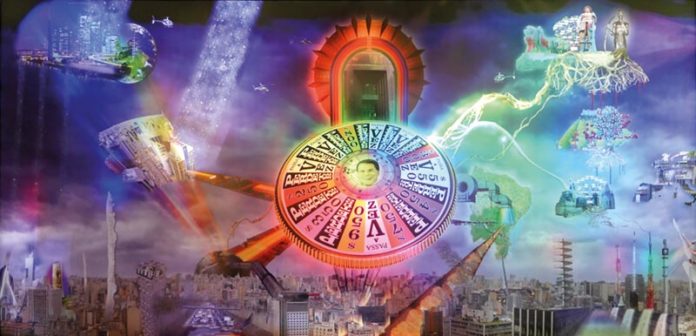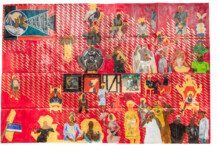
The Superfictions conceived by Guerreiro do Divino Amor could also be called, according to himself, hyperrealistic, neorealistic or documentary. For through them, in the series of works entitled World Superficial Atlas, the 36-year-old Swiss-born artist based in Rio brings to light some of the deepest and most complex themes of our society, both geopolitical and collective imaginary. Current – and not fictional – issues such as political, religious, media and marketing powers, social inequalities, state violence, and population whitening strategies.
In videos that unfold in panels, magazines and other media, Guerreiro presents the superficial universes of each city or region in which he works, from an apocalyptic perspective and the realization that we live in war. From 2005 to now have been immersions in Brussels, Rio, Sao Paulo, Minas Gerais and Brasilia. The artist does not fear “call a spade a spade” when he prints in the videos, “like totems”, faces of powerful figures such as Silvio Santos, Doria, Bonner, Cunha, Malafaia and Pastor Davi Miranda. He was even sued by Miranda’s daughter, but acquitted “in a very pretty sentence. A relief, because today we do not know what to expect from justice”.
With a very peculiar aesthetic, strong colors and references to the internet universe, the artist questions the tasteful ideas and hegemonic visual patterns, sometimes in a mocking and ironic way. With a degree in architecture in Brussels, he says he found the usual way of presenting projects, all a bit gray and neutral, “a nonsense.” He preferred to resume his references from childhood and adolescence, from soap operas and music videos to Xuxa shows – “I think pop moves the heart more, has this direct and wider impact” – and deepens “the research of aesthetics as fiction, while observe how each social segment creates a fictional aesthetic that carries well-defined codes”.
His Atlas should now win episodes in Switzerland, “which has this perfectionary narrative of perfection”, in Italy, “in search of the roots of Christianity and fascism, very important for understanding Sao Paulo and southern Brazil”, and in Mexico. Guerreiro was the winner of this year’s Pipa Prize, one of the most important visual arts prizes in the country, and was interviewed by ARTE!Brasileiros.
ARTE!Brasileiros – To begin with, I would like to ask you where this name comes from, Guerreiro do Divino Amor (Warrior of the Divine Love), and what it means to you.
Guerreiro do Divino Amor – Warrior is my last name. Divino Amor was a joke that came about when I was a teenager and my father was dating a church pastor. She wanted to get me into the church, and it was a bit of a tease, I wanted to set up a heavy metal band to act in the church. It never happened, but I really liked the name, that means Warrior of the Divine Love. Then it gained many meanings linked to my work and life, until today it represents something as my life mission.
Could they ever get you into church?
No. In fact I was very curious about that neopentecostal universe that I didn’t know well. It was one of the engines of my work, trying to understand that overwhelming faith and at the same time with a very strong, colorful aesthetic. It was engaging.
It seems to me that many of your life experiences are very present in your work. You have talked about another part of the family that comes from a decaying aristocracy, besides their formation in Europe…
Yes, I think it was an engine. They lived in Europe, in a context where everyone was relatively mixed, and from time to time frequented family in Brazil, they were a deeply racist people, very futile, but with a certain cultured veneer, an obsession for power, hierarchy and status and the certainty of knowing that everything and everyone is in their place. I wanted to understand what were the mechanisms of perpetuation of this caste that continued to live in colonial Brazil without being disturbed. And also of this evangelical world. They are worlds within themselves, with answers to everything. I began to dig, to dig, and it began to appear as a bottomless hole with very old and deep roots, complex and perverse logic of domination. The work is all about unraveling these structures, which because they are so old and familiar form like an ecosystem, a given, timeless thing. And see the role of media, family, genealogy, inheritance, symbolic capital in this maintenance. The SuperRio, the second chapter of the Atlas, is a more direct portrayal of this attempt to understand what was around me and its relationship to more global marketing phenomena, corporate logic, and how it influences people’s minds and actions, what are their strategies and how does this translate to all scales, from individual to geopolitical. Then I explored other adjacent phenomena. So it began, in trying to understand these universes and the relations between them, and I still work on these issues.
And how do these Superfictions, these chapters, relate to each other in this great World Atlas?
In the beginning each project had its independence, explored its own themes. Only later I understood this as an Atlas. These are chapters that relate, with issues that go through the whole work, such as the ideas of empire and galaxy, the war between civilizations in their different social, religious, economic, symbolic and aesthetic facets, the different strategies of whitening the population. In the first chapter in Brussels, it was a more strictly analytical thing. It is a very poor city and dirty by European standards, but with an attempt to build itself as a world city scenario, capital of Europe. And when I was studying architecture, I began to realize a very warlike discourse, conquering minds and space. This idea runs through all the work in different ways. And the idea of superfiction really came in the next work in Rio, which I wrote in 2005 and resumed in 2013, in the pre-World Cup and Olympics period, the apex of Rio’s superfiction. Many times in my videos, I start from tourist films, advertisements, which is how the city wants to sell itself, what fiction it will create to export, this image creation.
But you start from what the city wants to show to expose what the city doesn’t want to show…
Yes, as they are very elaborate and ancient constructions, I try to identify the symbolic and historical roots and their different manifestations, how these fictions are incorporated into the collective imagination of the city, and how they act and are instrumentalized in the different wars for power. In the case of Minas this is also very strong. Minas is a bit of “red hot cuteness”. No one will speak badly of Minas Gerais, which has that food, an ideal of hospitality. But other than that it’s a place of power, of money, it’s one of the few states that doesn’t have Black Consciousness Day, despite its past, it’s all very veiled.
In the surface you work with various planes and layers of power that characterize societies as politics, religion, media, police, market. How do you choose these worked themes?
It’s very natural, coming to places and watching, feeling, talking. Of course all of these layers are present everywhere, but in each they act differently with other narratives. For example, religion works in different ways in every place, even with very different physical constructs and different preaching styles. But deep down, with the same desire for conquest. In the case of the media too. In Rio, for example, it has a very strong media construction through both soap operas and police news, creating this schizophrenic narrative, represented by the wind rose in the SuperRio. In MG you always see a narrative of a “back to the soil”, a more rural image, a more pure idea, and this is exalted in the media.
And your work is always questioning these official narratives, bringing hidden things.
Yes, the fiction of racial democracy, for example, which in each place is narrated in a way. And it is one of the central fictions of Brazil’s construction, which serves to appease, exploit. This denial of the slave past. Speaking of Minas again, which is the coolest thing for me, there’s all this instrumentalization of the Chica da Silva myth. Everywhere you go there is this narrative that says “look, there’s Chica da Silva, rich, beautiful slave”. And then it looks like it’s all right. The thing gets more subtle, but perhaps for that very reason more perverse. With this layer of honey, sweet frosting.
In addition to dealing with real cities, many real figures also emerge. How do you choose these characters and how do they fit into the work?
They are icons, right? They are like totems. For example, Silvio Santos, his life, his career, is like a São Paulo totem. It is the embodiment of the myth of meritocracy. And working in photoshop I saw that he and João Doria have very similar traits. So at work they come together as one. They complement each other. Because Doria is also like a caricature, an archetype of the heir, of savage capitalism. You see these figures and you already know what they are about, they already bring a whole universe together. And they are not abstract phenomena. These are people who are acting there, an army. Of course there are many others, it is much more complex than that.
You once said that your work seeks to deal with the complexity of apocalypse. You also said that the whole work is about war on different levels. Anyway, are we in the apocalypse? Are we into war?
There is this perception that there is an apocalypse, at all levels, in the matter of natural resources for example. And the work tries to see these details, as this is a construction, it is a war that comes from far away. In Brasilia’s work, for example, I saw these cycles, as in the inauguration of Brasília reenacted the first mass of Brazil, of the time of the conquest. It is an apocalypse that has been preparing for many centuries, but now it is as if it were the apotheotic moment, which came in earnest. And working on it, messing with these things is sometimes scary. It became clearer throughout the chapters, having its apex in Brasilia, where the research was done at the time of the 2018 elections. It seems that the slaveholders got the perfect formula. The combination of the power of faith with emotional marketing and information technology is overwhelming.
At the same time as we have this apocalyptic framework, the artistic milieu has given recognition to works that deal with racial, indigenous, gender, and so on.
You just won Pipa, for example. Is it a resistance to the apocalypse?
I think maybe the art world has awakened more now too because things started to reach a “whiteness” that was quiet, protected, trapped in a romanticism. But there are people who were already used to persecution, who have wisdom about being at war. And I think the arts may now turn more to these, the ones who already know what it’s about. When there is a need, everything is learned faster.







